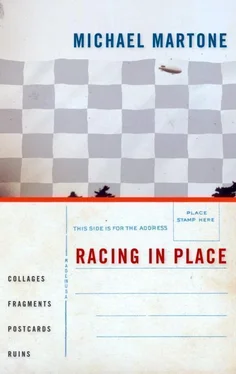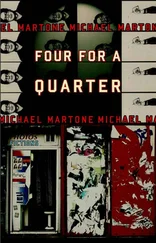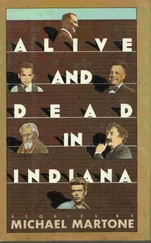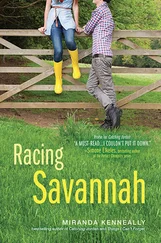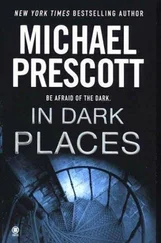11. Can you tell us a story? If books are like places, then places are like books. Let me tell you a story. I was helping a farmer during planting. I was driving a tractor vibra-shanking a field of soybean stubble as the farmer followed behind me planting corn. The operation I was asked to do was an easy one, but I don't have much aptitude for machines. I wound up during one pass almost sliding into a ditch of water when I tried to make the turn. Braking, I stalled the engine, and shaken, I couldn't get the thing in gear to start up again. The farmer all this time was steadily catching up. The harder I tried to free myself and prove my competence, the worse things got. The farmer's son was working in the next field. He yelled to me that he was on his way to help. In a few minutes I saw him poling down the ditch on a raft made of old fence posts, and he saved the day. There isn't much to the story. That's not why I told it. What is interesting is that when I visit that farm now sooner or later that little story is told again-how Michael got stuck and Eric came to the rescue. Sometimes it is told to people who haven't heard the story. But more often than not, we tell it to ourselves. It is as if the story is another building constructed a few springs ago. It is a part of the layout of the place, part of the map. This little story takes its place with hundreds of others. The field where I had my adventure is called Cottonwood for the tree that used to be there sixty years ago. When Farmer Brown tells Eric to cultivate Cottonwood, it is a one-word story. The tree no longer exists. The story does. Places exist in two dimensions. They exist in the physical realm, but also in time. I will exist as part of a place on that farm as long as people tell the story. Though the dirt, the ditch, the crops exist; a place needs a person to name it. Cottonwood. It is interesting what we call the documents that transfer land: deeds and titles. The land itself carries its own deeds and titles. To gain a sense of place is to be sensitive to stories about places.
12. Here's your hat; what's your hurry? A sense of place is a complex idea further confounded by our relationship to it. We all labor to resolve two opposing forces in our lives. On one hand we have a desire to be rooted, to belong-literally to be long-in a place. On the other hand, we wish to be free of those connections, to keep moving through. As with all compelling conflicts, this one is not easily resolved, probably not to be resolved. People now move far more than they stay put. By moving we find it easier to ignore those limits imposed on our lives. The fences on either side of the road seem more like a chute channeling us on to some wonderful future. To have a sense of place is to sense limits, to sense our own deaths, a specific plot of ground where we will be buried and where our bodies will become part of the plot of ground. By accepting the limits a place imposes, we gain the ability to leave a mark. By being part of a place, we become it.

1
I found myself in a room with nine pregnant women. All of the women were in the very late stages of their pregnancies-very late. Their deliveries past due, they waited in this converted surgical recovery room for their labors to commence. All of them were massive. Their shapeless hospital gowns taking on now the sweeping contours of their swelling bellies and breasts amplified their heft by defining it, the fabric stretched taut across the rounded middles. They all were hugely uncomfortable, in pain, of course, and in various postures of steeping agony-standing, sitting, or splayed in a bed. They had all been induced, that is to say the synthetic hormone pitocin had been introduced into their blood streams via an intravenous drip to spark their bodies into productive contractions. And it was working in spades. The spasms now slamming through them were juiced by the chemical, boosted, turbo-charged. The kick they were receiving packed a bigger wallop than if the body had kicked off on the process of its own accord. This was truly gut-wrenching, a doubled definition of "spike" of pain. Some were hooked up to monitors that spit out a graph paper narrative scored with these mountain ranges of ragged edges that finally climbed and climbed-no denouement but only the inked evidence of one endlessly upward sloping excruciation.
I had been told to wait in the recovery room with nine women in the throes of labor by a distracted doctor at the main desk. My wife, on the verge of birthing her first son (birth imminent, the chart had read), stalled in the delivery during the final pushing. She had been whisked off to surgery for a c-section, leaving me alone in the birthing room with the beeping Plexiglas incubator warming up in the corner.
"What are you doing here?" an orderly asked as he wheeled in a bucket and mop to begin cleaning. I told him no one, in the haste to get to the operating room, had told me where to be, where to go. "Man, you can't be here," he said, "I've got to get this room ready for the next one. They're stacked up out there." So I drifted down to the desk and to the distracted doctor who told me to take a seat in the recovery room.
The women in the room began, in their individual expressions of pain, to come into a communal tune. Each whelp or moan began to synchronize, a kind of round harmony. The sound was transmitted around the room, an a cappella fugue of agony. The women peaked one after the other. The last one subsiding into a whimper just as the next reached a muscular grunt and growl. It was as if there was only one big contraction that oscillated around the room or that, in fact, the room itself rippled in one long ululation of a continuous sustained contraction. Nurses and midwives whispered to their laboring patients to "ride" the contraction, and the cacophony in the room had the orchestrated order of the squealing shriek of a train of roller coaster cars. As each woman emerged from her most recent bout with her body (her body that now was not her body but possessed by these biological imperatives and hormonal accelerants that split open a body to expel another body), each opened her eyes to see me sitting by the door. And as they focused on me, as they waited for the next spasm to grip them, I could tell they really, really didn't want me there.
2
In high-school health classes, it once was popular to have the students carry around, for days or weeks at a time, ten-pound bags of flour. The exercise was meant to simulate the weight of a newborn baby and the sustained lugging to condition the sexually active or soon-to-be sexually active teenager to the consequence of sexual activity, pregnancy, and the consequence of the consequence, live birth. The flour bags would be hauled to classes, held while eating lunch, babysat in gym class. Some students even dressed their bags of flour or pretended to change the bag of flour's diaper, an apparent mass hysteria to better imagine this potential semiattached dependent human mass.
Ten pounds! It is interesting that the birth announcement boilerplate contains a space for the newborn's weight. What other formal communication announces that information? Obituaries do not state that, at the time of death, the deceased tipped the scales at a svelte 185. Nor do wedding invitations report the fighting weight of the bride and groom. Perhaps there is just not that much to describe when we describe a baby, a baby so easily disguised as a bag of flour. We are left with the basics. Color of hair and eyes can change, and so such intelligence is rarely shared. The kid's size, the length and weight, is hardly static, and yet it is duly noted along with the name and the time and date of delivery into the world. Most likely we broadcast the heft of the infant because all through gestation it has been the focus, this hidden relentlessly growing thing, this curious expanding loaf, a kind of staple. The newborn remains pretty much that way for months outside the womb, a swaddled package. In short, the baby is an embodiment of human weight itself. It boils down to bulk. Ten pounds!
Читать дальше
